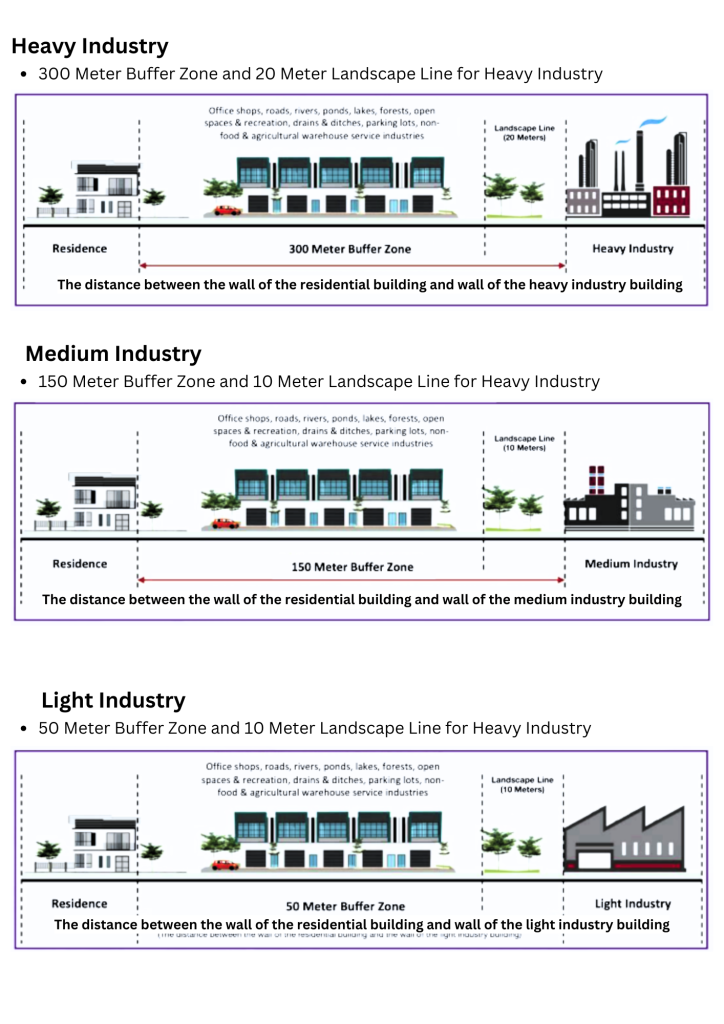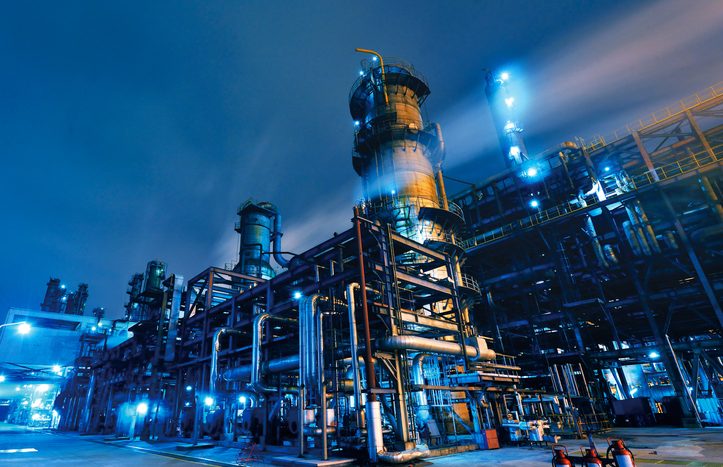Sector of Light, Medium, & Heavy Industries
Exploring Malaysia’s Industrial Sectors: Light, Medium, or Heavy Industries.
| Light Industry Light industry refers to manufacturing processes that have minimal impact on the environment and public health. These industries produce goods with low pollution potential, including air emissions, noise, vibration, odors, and risks of fire or explosion. They do not utilize hazardous materials in production or generate hazardous products. Light industries typically rely on renewable or low greenhouse gas emission energy sources. Additionally, they generate negligible wastewater and solid waste, with any waste produced being non-hazardous and not contributing significantly to pollution. |
| Medium Industry Medium-scale industrial activities pose a moderate risk to the environment and public safety due to potential hazards such as fire, explosion, and the use of hazardous chemicals. These industries have a moderate level of air pollution potential, including odors, from residual air pollutants. They also contribute moderately to greenhouse gas emissions and may emit ozone-depleting substances. While they generate moderate levels of noise and vibration, their residual impact is not significant. These industries produce significant quantities of wastewater containing low levels of pollutants. Additionally, they generate scheduled wastes, most of which can be effectively treated or managed in designated facilities. |
| Heavy Industry Industries with high pollution potential pose significant risks to the environment and public safety due to factors such as fire, explosion, radiation, and the use of highly hazardous chemicals. They exhibit high air pollution potential, including odors, stemming from residual pollutants in both fugitive and source emissions. Despite these challenges, they prioritize the use of renewable or low greenhouse gas emission energy sources. Moreover, they generate minimal or no wastewater that could contribute to water pollution. Additionally, these industries produce non-hazardous solid waste and negligible amounts of scheduled wastes, thereby minimizing their environmental impact. |
Buffer Zone between Industrial Area and Residential Area

Enforcement of the buffer zone requirement falls under the purview of the Malaysian government, guided by the Environmental Quality Act of 1974. This legislation sets forth standards for air quality and noise levels within residential areas.
Don’t forget to quickly determine which sector your business falls under!
| LIGHT INDUSTRY SECTOR |
| 1. Food Processing: The sector entails the meticulous processing and preservation of fruits and vegetables, alongside crafting beverages such as wines, soft drinks, and mineral water, catering to diverse consumer preferences and demands. 2. Textiles: This sector encompasses the intricate processes of spinning, weaving, and finishing textiles, coupled with the preparation and spinning of textile fibers, ensuring the creation of high-quality fabrics tailored for various applications and markets. 3. Wood and Paper Products: This industry encompasses the skilled craftsmanship involved in manufacturing wood products, ranging from furniture to building materials, as well as producing paper and paperboard products vital for packaging, printing, and other purposes. 4. Chemicals and Chemical Products: In this sector, a wide array of basic chemicals, dyes, printing inks, and other chemical products are meticulously crafted, meeting the stringent quality standards for industrial, commercial, and household applications. 5. Rubber and Plastic Products: This sector excels in the production of rubber and plastic goods, including tires, hoses, bags, and bottles, offering durable and versatile solutions for various industrial and consumer needs. 6. Electrical and Electronic Equipment: Embracing innovation, this sector manufactures electric motors, batteries, electronic components, and consumer electronics like televisions and computers, meeting the evolving demands of modern society with cutting-edge technology and reliability. |
| MEDIUM INDUSTRY SECTOR |
| 1. Animal Production: Encompasses the cultivation and breeding of domesticated animals, operation of worm farms, and beekeeping practices, contributing to agricultural sustainability and meeting diverse commercial demands. 2. Other Mining and Quarrying: Includes various mining and quarrying activities, such as the extraction of industrial sand, vital for construction and industrial processes, ensuring the steady supply of essential materials. 3. Manufacture of Food Products: Involves the production of a diverse range of food products, meeting nutritional and industrial needs with quality ingredients and processes, ensuring consumer satisfaction and industry standards. 4. Manufacture of Beverages: Encompasses meticulous processes in manufacturing malts, distilling, rectifying, and blending spirits, catering to diverse consumer preferences and connoisseurs in the beverage industry. 5. Manufacture of Textiles: Encompasses comprehensive processes in preparing and spinning textile fibers, alongside manufacturing textiles, cordage, rope, twine, and netting, serving various applications in textiles and related industries. 6. Manufacture of Wood and Products of Wood and Cork: Includes the production of wooden containers, builders’ carpentry, articles of straw, plaiting materials, and other wood products, meeting construction, packaging, and craft needs sustainably. 7. Manufacture of Paper and Paper Products: Encompasses the production of pulp, paper, paperboard, and corrugated paper products, meeting diverse packaging, printing, and industrial needs with quality materials and processes. 8. Manufacture of Chemicals and Chemical Products: Includes the production of a wide range of chemicals and chemical products, serving diverse industrial and consumer applications with precision and quality. 9. Manufacture of Rubber and Plastic Products: Encompasses the production of rubber tires, synthetic rubber, and processing plastic resins into intermediate or final products, addressing various industrial and consumer needs with durable solutions. 10. Manufacture of Other Non-Metallic Mineral Products: Includes the production of glass, clay building materials, porcelain, and other non-metallic mineral products, meeting construction, manufacturing, and artistic needs with quality materials and craftsmanship. 11. Manufacture of Basic Metals: Encompasses the production of basic precious and non-ferrous metals, serving various industrial and commercial applications with high-quality metal products. 12. Manufacture of Fabricated Metal Products, except Machinery and Equipment: Includes the production of structural metal products, weapons and ammunition, and other fabricated metal products, meeting diverse industrial, defense, and commercial needs with precision engineering. 13. Manufacture of Electrical Equipment: Encompasses the production of batteries, wiring and wiring devices, and lighting equipment, meeting diverse electrical needs with efficiency and reliability. 14. Manufacture of Machinery and Equipment n.e.c: Includes the production of general-purpose machinery, fluid power equipment, lifting and handling equipment, and special-purpose machinery, catering to diverse industrial and commercial needs with innovation and reliability. 15. Manufacture of Motor Vehicles, Trailers and Semi-Trailers: Encompasses the production of motor vehicles, bodies (coachwork) for motor vehicles, trailers, semi-trailers, and parts and accessories, meeting transportation needs with cutting-edge technology and safety features. 16. Manufacture of Other Transport Equipment: Includes the production of ships and boats, transport equipment, and motorcycles, addressing diverse transportation needs with quality craftsmanship and advanced engineering. 17. Manufacture of Furniture: Encompasses the production of a wide range of furniture, meeting diverse residential, commercial, and institutional needs with quality craftsmanship, innovative designs, and sustainable materials. 18. Repair and Installation of Machinery Equipment: Encompasses the repair of fabricated metal products, machinery, and equipment, ensuring the continued functionality and safety of industrial and transportation assets. 19. Electricity, Gas, Steam and Air Conditioning Supply: Includes electric power generation, transmission, and distribution, as well as the production, collection, and distribution of steam and hot water, providing essential energy and heating solutions for various purposes. 20. Sewerage: Encompasses the operation of sewer systems and sewage treatment facilities, ensuring proper sanitation and environmental protection through effective wastewater management and treatment processes. |
| HEAVY INDUSTRY SECTOR |
| 1. Animal Production: Encompasses the breeding and husbandry of farm animals, including racing horses and other equines, meeting diverse agricultural and recreational needs with expertise and care. 2. Mining and Quarrying: Includes the extraction of coal, lignite, iron ore, bauxite, gold, and various minerals from the earth’s crust, contributing to industrial and economic development with sustainable practices. 3. Extraction of Crude Petroleum and Natural Gas: Encompasses the extraction of crude petroleum and natural gas, along with on-site processing, ensuring the efficient recovery and utilization of valuable energy resources with advanced technologies and safety measures. 4. Mining of Metal Ores: Includes the extraction of various metal ores from mines, supporting metal production and supply chains with responsible mining practices and environmental stewardship. 5. Other Mining and Quarrying: Includes various mining and quarrying activities, supporting construction and infrastructure projects with high-quality materials and sustainable practices. 6. Mining Support Service Activities: Offers essential support services for petroleum and natural gas extraction, mining, and quarrying operations, ensuring operational efficiency, safety, and compliance with regulatory standards. 7. Manufacture of Food Products: Encompasses the processing and preservation of meats, fish, crustaceans, mollusks, and the production of hides, skins, and animal offal, meeting food safety standards and consumer demands. 8. Manufacture of Textiles: Encompasses comprehensive processes in spinning, weaving, finishing textiles, and preparing and spinning textile fibers, contributing to the textile industry’s value chain with quality products and sustainable practices. 9. Manufacture of Leather and Related Products: Encompasses the tanning, dressing, and drying of leather, along with fur dressing, ensuring the production of high-quality leather and fur products with attention to craftsmanship and environmental standards. 10. Manufacture of Wood and Products of Wood and Cork, except Furniture; Manufacture of Articles of Straw and Plaiting Materials: Encompasses sawmilling, planning wood, and manufacturing various products from wood, cork, straw, and plaiting materials, supporting construction, manufacturing, and craft industries with sustainable sourcing and quality craftsmanship. 11. Manufacture of Paper and Paper Products: Encompasses the production of pulp, paper, paperboard, and bleached, semi-bleached, or unbleached paper pulp from virgin wood, supporting diverse paper and packaging needs with eco-friendly processes and innovative technologies. 12. Manufacture of Coke and Refined Products: Encompasses the production of coke, oven products, and refined petroleum products, ensuring the availability of essential materials for industrial processes and energy supply with efficient production processes and environmental responsibility. 13. Manufacture of Chemicals and Chemical Products: Includes the production of basic chemicals, organic and inorganic chemicals, supporting various industries with high-quality chemical products and advanced manufacturing processes. 14. Manufacture of Rubber and Plastic Products: Encompasses the production of rubber tires and tubes, meeting transportation and industrial needs with durable and high-performance rubber products manufactured with advanced technologies and quality control. 15. Manufacture of Other Nonmetallic Mineral Products: Encompasses the production of glass, cement, lime, clinkers, and refractory products, supporting construction, manufacturing, and industrial applications with high-quality mineral products and sustainable manufacturing practices. 16. Manufacture of Basic Metals: Encompasses the production of basic iron and steel, including blast furnace and steel converter operations, supporting metal manufacturing and supply chains with quality metals and efficient production processes. 17. Manufacture of Fabricated Metal Products, except Machinery and Equipment: Encompasses the production of structural metal products, tanks, weapons, ammunition, and metal forging, pressing, stamping, and roll-forming, meeting diverse industrial and defense needs with precision engineering and quality fabrication. 18. Manufacture of Other Transport Equipment: Encompasses the manufacture of ships, boats, railway locomotives, air and spacecraft machinery, and military fighting devices, meeting transportation and defense needs with advanced engineering and technological innovation. 19. Electricity, Gas, Steam and Air Conditioning Supply: Encompasses electric power generation, transmission, and distribution, as well as gas manufacturing and distribution, providing essential energy and heating solutions for various industrial, commercial, and residential applications. 20. Waste Collection, Treatment, and Disposal Activities; Materials Recovery: Includes waste treatment and disposal, as well as materials recovery activities, ensuring environmental sustainability and resource conservation through effective waste management and recycling processes. |
Disclaimer: Reference made to “Guidelines for Siting and Zoning of Industrial and Residential Areas” as published by Department of Environment (DOE). We do not take any responsibility and not liable for any misunderstandings, loss and damages caused by information above. Kindly consult Department of Environment (DOE) for more detailed information.





